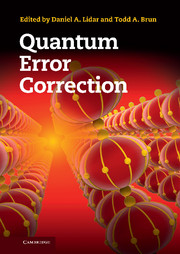Book contents
- Frontmatter
- Contents
- List of contributors
- Prologue
- Preface and guide to the reader
- Acknowledgements
- Part I Background
- Part II Generalized approaches to quantum error correction
- Part III Advanced quantum codes
- Part IV Advanced dynamical decoupling
- Part V Alternative quantum computation approaches
- Part VI Topological methods
- 19 Topological codes
- 20 Fault-tolerant topological cluster state quantum computing
- Part VII Applications and implementations
- Part VIII Critical evaluation of fault tolerance
- References
- Index
19 - Topological codes
from Part VI - Topological methods
Published online by Cambridge University Press: 05 September 2013
- Frontmatter
- Contents
- List of contributors
- Prologue
- Preface and guide to the reader
- Acknowledgements
- Part I Background
- Part II Generalized approaches to quantum error correction
- Part III Advanced quantum codes
- Part IV Advanced dynamical decoupling
- Part V Alternative quantum computation approaches
- Part VI Topological methods
- 19 Topological codes
- 20 Fault-tolerant topological cluster state quantum computing
- Part VII Applications and implementations
- Part VIII Critical evaluation of fault tolerance
- References
- Index
Summary
Introduction
What a good code is depends on the particular constraints of the problem at hand. In this chapter we address a constraint that is relevant to many physical settings: locality. In particular, we are interested in situations where geometrical locality is relevant. This typically means that the physical qubits composing the code are placed in some lattice and only interactions between nearby qubits are possible. In this case, it is desirable that syndrome extraction also be local, so that fault tolerance can possibly be achieved. Topological codes offer a natural solution to locality constraints, as they have stabilizer generators with local support.
In topological codes information is stored in global degrees of freedom, so larger lattices provide larger code distances. The nature of these global degrees of freedom is illustrated in Fig. 19.1, where several closed curves in a torus are compared. Consider curves a and b. They look the same if examined locally, as in the region marked with dotted lines. However, curve a is the boundary of a region, whereas curve b is not. In order to decide whether a curve is a boundary or not we need global information about it. This is, as we will see, a core idea in topological codes.
- Type
- Chapter
- Information
- Quantum Error Correction , pp. 455 - 481Publisher: Cambridge University PressPrint publication year: 2013
- 14
- Cited by



